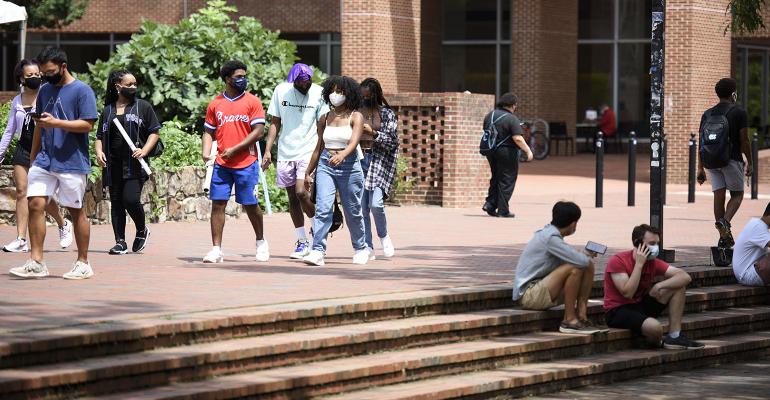This is an uncertain time for college students and their parents. No one knows with any confidence how COVID-19 will ultimately impact the current school year.
It’s equally unnerving, however, for parents whose children are planning to head for college in the fall of 2021 or later.
Hopefully, the pandemic will be gone by the start of the 2021 school year—or severely limited by then—but in the meantime, students will have to navigate the college process during a pandemic.
Some of the admission changes that were instituted or strengthened during the public health crisis will likely continue indefinitely, so clients with younger teenagers should understand that these changes could apply to them too.
Better deals
In reaction to the pandemic, schools made some last-minute changes to their admission practices for high school students planning to attend college in the fall of 2020. The pandemic hit the admission season late. By the time Americans were aware of it, the admission season was nearing an end.
Even so, the pandemic did disrupt the admission cycle in significant ways that I expect will continue.
One major move was that many schools were more likely to entertain appeals for additional money this year. Many families who appealed needed additional help because the pandemic significantly hurt their finances.
The income of a household where a parent was laid off or had hours cut this year would not be reflected on the Free Application for Federal Student Aid or the CSS Profile, which roughly 200 colleges use for undergraduate admissions. These aid applications use two-year-old tax returns, which would be irrelevant for many families that enjoyed higher income two years ago.
Families should have a better shot at additional help from colleges that are at risk of not filling their freshman slots. Schools that fall into that category include private institutions that are not located in coastal cities and are located in areas such as the Midwest that have fewer teenagers than they used to.
Families should not hesitate to appeal, even if their financial need is not connected with the pandemic.
To understand how much a school might kick in, a family needs to understand what their Expected Family Contribution is. An EFC is what a family would be expected to pay, at a minimum, for one year of college and it’s based on a household’s income tax return(s) and nonretirement assets.
Ideally, a family’s EFC will be included on a school’s financial aid letter, but often it isn’t there. Ask the school what EFC is used and remember it would be based on two-year-old tax returns. Parents can also run their own EFC by using the College Board’s EFC calculator.
What your clients should know is that you don’t need financial assistance to ask for more money. A student can request a bigger merit scholarship as well.
The majority of private colleges have annually struggled to fill their freshman slots, and the pandemic made an already challenging situation worse. This means that some schools, but not the most selective, will be even more motivated to offer better deals, regardless of need, to families that speak up.
Thanks to sophisticated enrollment management algorithms, many schools aim to determine just what kind of an award a student would need to persuade them to enroll. If a student balks at the offer, schools that need more students are more likely to boost the award.
A family will strengthen their chances at a better discount if the student possesses better offers from other schools. Parents or the child can approach the school and offer to scan and share the competing offers.
Affluent students can continue to benefit
The pandemic has pushed college costs out of reach for an increasing number of families, which will likely benefit affluent students who can pay the tab at state and private universities. I predict that high-income students will be even more desirable now.
You can appreciate this when you look at what happened at state universities during and after the Great Recession of 2007–2009. During the recession, state government support for public universities dropped considerably, which prompted schools to find additional sources of income. A major way universities did this was to offer merit scholarships to affluent students within their state and beyond their borders. Even with merit awards, these affluent students still would pay more than residents who required financial aid.
The financial challenges are even worse today for state schools, so there is no reason to think the merit scholarship trend won’t continue.
The desirability of high-income students has also increased at private colleges that are worried about their own survival. Boosting merit awards to high-income students and accepting fewer applicants, who need considerable help, is one way to generate more revenue.
A New York Times article published during the Great Recession illustrates how this phenomenon works. The article shared the story of Reed College, an elite liberal arts college in Portland, Ore., which took more than 100 students off its tentative acceptance list in 2009 because they required aid. The school replaced those students with affluent applicants, who weren’t as accomplished but could pay full price.
Nearly all schools practice some form of what’s called need-aware or need-sensitive admissions. When financial aid resources are dwindling, schools start rejecting financial-aid applicants and favor full-pay students instead.
Lynn O’Shaughnessy, a nationally recognized college expert, offers an online course – Savvy College Planning - exclusively for financial advisors. Click here to get Lynn’s guide, Finding the Most Generous Colleges.





